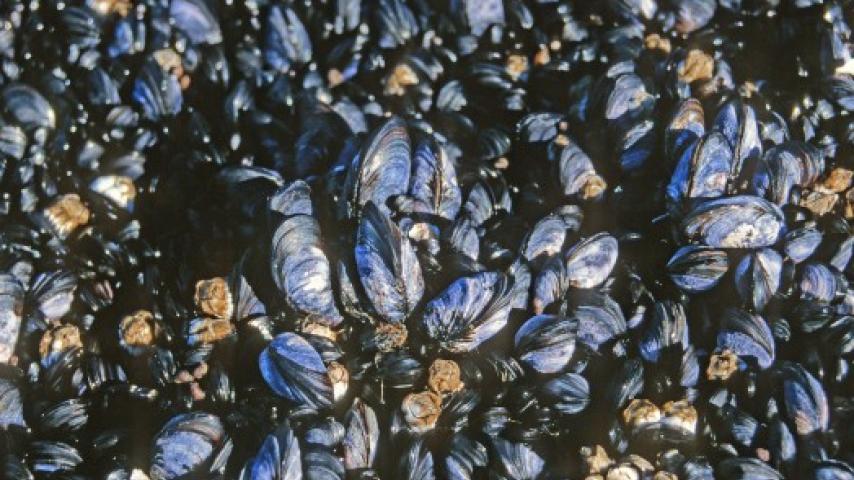Pacific Blue Mussel (Mytilus trossulus)
Mussel colonies are major features in protected marine waters of the Pacific Northwest. Among the most characteristic and abundant animals of bay shorelines everywhere, Blue Mussels blanket the rocks in assemblages of hundreds and even thousands of individuals. The colonies also form on docks and may completely cover pilings below the high-water line.

KINGDOM Animalia - PHYLUM Mollusca - CLASS Bivalvia - ORDER Mytiloida - FAMILY Mytilidae
Mussel beds are limited both above and below by predators. On the shore side, shorebirds, gulls and crows eat them, and at low tides they are quite vulnerable. On the seaward side of the bed, they are devoured by numerous species of sea stars, as well as anemones, snails, crabs, and fishes. Diving ducks such as scoters and Harlequins take them whenever they are submerged.
Mussels attach themselves to the rocks by means of byssal threads that they produce and attach with their foot. They have an impressive way of dealing with dogwinkles that prey on them. When a carnivorous snail attempts predation, the mussel reaches out with its foot and attaches the snail to some nearby substrate with some byssal threads! If attached firmly enough, the snail stays there and dies.
As most bivalves, mussels are filter feeders. When submerged, they feed almost continuously on plankton and detritus, including bits of dislodged kelp blades, which may make up a majority of their diet in some areas. Because of their detritus and plankton feeding, their abundance, and their availability to predators, Pacific Blue Mussels comprise a significant component of local food webs.
Blue Mussels spawn in spring in Puget Sound. The eggs develop rapidly and hatch into veliger larvae in a few days. The larvae enter the plankton, their movements aided by long byssal threads they secrete, and drift around for a month or two before they settle out onto varied substrates as tiny bivalves. Each individual lives for at least several years.
Because the Mediterranean Blue Mussel Mytilus galloprovincialis has been imported into Puget Sound for aquaculture, the present population of the region comprises both of these species. There are no ecological or genetic barriers against hybridization, so hybrids are frequent throughout the region. Generally M. galloprovincialis occurs on the average lower in the intertidal zone than M. trossulus and more often on docks, but at many sites they occur together. This may be a case of peaceful coexistence between a native and an invasive species, with no serious consequences to the ecosystem no matter how the populations of the individual species wax and wane.


